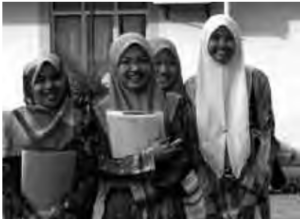During the summer of 2007, I traveled to Malaysia with four undergraduate students to study the lives of Malaysian youth. The youth-on-youth approach gave us an intimate look into the religion, social lives, and values of young Malaysians. We were interested in examining the ways in which ethnicity shaped the lives of young people in this multi-ethnic society. Malaysia is a geographically and ethnically diverse Southeast Asian country. It consists of eleven states on a long, narrow peninsula and two states on the neighboring island of Borneo. The capital, Kuala Lumpur, and the cities of Labuan and Putrajaya, lie within a separate federal territory. The three major ethnic groups are Malay, Chinese, and Indian. There are numerous smaller indigenous groups in rural peninsular Malaysia and in the Borneo states. Together the native Malay and non-Malay indigenous groups are known as Bumiputera— sons of the soil.
The majority population of Malaysia is Malay, but Malays only make up about 50.4 percent of the population. By Malaysian constitutional definition, in order to be classified as Malay, a person must speak Malay, practice Malay customs, and be Muslim. Despite representing only half of Malaysia’s population, the Malays retain political power and benefit from numerous affirmative action policies that the government initiated after serious race riots in 1969. These policies were designed to decrease economic differences between Bumiputera and immigrant groups to Malaysia, and they resulted in economic advantages for the indigenous group. Some Bumiputera privileges include government contracts and civil service jobs, higher Bumiputera quotas for university admissions and scholarships, discounted housing loans, and increased Bumiputera ownership of businesses, commercial, and residential property. These advantages, awarded only to “sons of the soil,” encourage an undercurrent of racial tension in the country.
Chinese make up approximately twenty-four percent of the population. Originally, Chinese immigrants made their way to Malaysia for economic opportunity, and today, they still represent a significant economic force. Chinese schools are considered the most academically rigorous in Malaysia, and the Chinese Malaysians are most likely to aspire to higher education.
The smallest significant ethnic group in Malaysia is Indian. Indians originally came from southern India to work as indentured servants on the rubber plantations. They now represent approximately seven percent of the population and tend to be laborers, although there is also a professional class of Indian doctors, lawyers, and other professions. While there is little support to maintain their native Tamil language, many Indian Malaysians often live in urban enclaves and struggle to maintain their culture in the face of modernization and Islamization.
The non-Malay Bumiputera people of Malaysia make up eleven percent of the population. The majority of this group reside in Sarawak and Sabah—the Borneo states. Among these groups are the Iban, Melanau, and Bidayu.
RELIGION
The Malaysian Constitution states, “Islam is the religion of the Federation; but other religions may be practiced in peace and harmony in any part of the Federation.” Each Malaysian citizen is required to state his or her religion on their national identity card. Muslims are subject to a dual layer court system that includes both civil and Islamic law. Islamic law takes precedence over civil law, and the Islamic or “morality” police have been known to raid nightclubs frequented by young Malaysians and to arrest Malays for “indecent attire,” drinking alcohol, or khalwat (close proximity).
GOVERNMENT
Malaysia is a constitutional monarchy with a British parliamentary two-house system of government. The government party that rules most of the country is the Barisan Nasional, made up of several political organizations. Recent elections in Malaysia (March 2008) revealed discontent with the government. The United Malays National Organization is the strongest voice and pushes an increasing movement toward Islamic conservatism in the country. Although the ruling party returned to power, it did not receive the two-thirds majority in the national Parliament that it had maintained for decades. Despite being perceived as a semi-democratic government, the Malaysian government is relatively authoritarian. For example, there is active censorship of the press, media, Internet, and arts. The list of banned books is extensive. University students are discouraged from voicing opinions that might oppose public policy, and the Internal Security Act permits arrest and detention without cause for up to two years.

IMPACTS OF MODERNIZATION
Malaysia’s Vision 2020 is the government’s plan to achieve an industrialized and fully developed nation status by 2020. Kuala Lumpur, the capital of Malaysia, boasts immense skyscrapers, the longest consecutive mass transit system in the world, five star hotels and restaurants, easy computer access, and satellite television that broadcasts the best and the worst of Western and Asian television. While there is less evidence of modernity in the smaller cities, one does not have to look far to find a modern shopping mall.
The median age of Malaysians is 24.6 years, and the impact of modernization has been most profound on Malaysian youth. Like young people everywhere who are exposed to changing social and moral values, the pressure is strongest on Malay youth, since modern values usually conflict with the traditions of Islam. Non-Muslim Malaysian youth have more freedom of expression because Islamic laws do not apply to them. However, when the government takes a conservative stance and shuts down the video arcades, as they did in 2000, everyone feels the effect.
Modernity impacts Malaysian youth profoundly, and it puts particular pressure on families. According to one demographic study, young Malaysians who are better educated and more exposed to modern values are likely to leave home earlier than those with less exposure. The portrayal of modern values is evident with the recent proliferation of reality television programs broadcast in Malaysia. In addition to Survivor and Fear Factor, both imported from the US, there are Malaysian equivalents such as Malaysian Idol, and Fantasy Academy. Scholars who published a 2006 study of reality television viewing in Malaysia reported that Malaysian officials complained that the shows reveal too much of Western culture and inadequately reflect Asian values.
RESEARCH ON MALAYSIAN YOUTH
The Malaysian government’s plan for its population is idealistic. The Ninth Malaysia Plan (2006–2010) hopes to create a population that is “knowledgeable, competitive, has a high performance culture, integrity, and strong moral values. It is also a society of learned people who appreciate culture, arts, and heritage, as well as the history of their nation, race, and religion. This society is known by its strong sense of self-esteem and is not easily swayed by the waves of globalization.” There has been little research that determines the extent to which young people share these values.
In 2002, the United Nations Economic and Social Commission for Asia and the Pacific undertook a lengthy project to focus attention on issues in youth education, employment, and health. The respondents made it clear that ethnic quotas for university admission increased racial tensions in the country, and expressed that the government should raise restrictions on free speech. Those surveyed also felt that the educational system did not encourage dialogue or creativity from youth and that, while they believed they could make a valuable contribution to Malaysian society, they were not taken seriously by their elders.
The Merdeka Center for Opinion Research conducted a second, more comprehensive study of Malaysian youth in 2006. This study did not explore the impact of modernization on the youth of Malaysia, but it did examine their interests, attitudes toward government and its policies, multicultural values, and their interest in and how they get the news. The findings are surprising, and reveal that modernity has a small impact on the lives of youth. Nearly half of those interviewed said their favorite pastime was reading or playing sports, and a mere eight percent said that going to the movies or watching television was a hobby. Most had not traveled outside Malaysia, and generally had little interest in the news or government activities. On moral questions, the researchers found Malay respondents were the most conservative and Chinese the most liberal.
WHAT WE DID
Given the complexity of Malaysian society and that people under twenty-five make up one fourth of the population, the goal of our study was to develop a comprehensive, descriptive picture of youth issues. We defined “youth” as Malaysians between fifteen and twenty-five. Of the 196 people interviewed, twelve percent were between the ages of fifteen and seventeen, forty-one percent were between eighteen and twenty, and forty-seven percent were between twenty-one and twenty-five.

Alone or in pairs, the US undergraduate students approached groups of young Malaysians in shopping malls, food courts, coffee shops, universities, and other spots where young Malaysians spend time. They used open-ended questions to stimulate conversation. The discussion topics included leisure and social life, dating behavior, family issues, education, religious commitment, and attitudes toward government.
Depending upon the English proficiency of those with whom we talked, the interviews typically lasted between fifteen minutes and two hours. In many cases, the Malaysian youth invited the American students to continue to socialize with them afterward. The advantage of having young US students ask questions was that the young Malaysians were very frank and open in their responses, as though they viewed the American students as friends. At the end of five weeks, the American students had interviewed young people from all major ethnic groups in four regions of the country—Kuala Lumpur, the capital of Malaysia; Melaka, a small city of largely Chinese or Malay-Chinese mixed ethnicity; Kota Bharu, a conservative Muslim city on the east coast of Malaysia; and Kuching, the capital of the Borneo state of Sarawak. While not an exact match, the ethnic breakdown of the interviewees is roughly representative of the overall ethnic breakdown within Malaysia.
Seventy percent of those interviewed were students. Twenty-five percent worked full time, and the remaining were unemployed or between high school and college. The majority of those who worked were Malay, and most of the students were Chinese or Indian.
WHAT WE LEARNED: SOCIAL NETWORKS
While nearly half of the young Malaysians claimed that they socialized in mixed ethnic groups, virtually all the groups that we observed in shopping malls, cafes, and university settings were of the same ethnicity, suggesting little social mixing. This was explained by one Malay girl who stated that, “Segregation happens naturally because of language barriers or parents’ viewpoints.” Another Chinese youth explained, “Malays hang with Malays, Chinese with Chinese, Indians with Indians. They agree to disagree. Everyone gets along, even if they don’t like each other.” The indigenous, mixed race, and Indian youth were most inclined to social mixing, while most of the Chinese and Malay youth acknowledged that they hung around with people of the same ethnicity.

Photo courtesy of Nancy Janus.
Perhaps government policies contribute to young people spending more time with friends of the same ethnic group. Chinese youth expressed repeatedly that they resented government favoritism toward the Malays. They were particularly angry over inequity in government-sponsored opportunities for higher education. One Chinese boy stated, “It is unfair how the government gives advantages to one race over another. I think it is important that you just learn to rely on yourself instead of the government!”
LEISURE ACTIVITIES
Even though the Merdeka study found that large numbers of Malaysian youth spent their leisure time reading, reading was not mentioned as a favorite leisure activity in our interviews.14 The most popular activity was lepak—loosely translated as loafing—which usually centered around food. Mamak shops—outdoor food stands clustered into food courts— are popular gathering places. A Chinese boy said, “If you want to find young people, they will be doing exactly what I am doing now—loitering in shopping complexes and eating with their friends.” Nightclubbing and activities that include alcohol were unpopular with most young Malaysians.

Photo courtesy of Nancy Janus.
About half of the youth engaged in hobbies or sports, and a third liked to go to movies or watch television. There were no ethnic distinctions in the preferences for these activities. Shopping was not mentioned as a primary leisure activity: “Shopping malls are really for lepak, not for shopping,” said a young Malay girl.
DATING BEHAVIOR
Questions about dating were often met by giggles and demure eyes from the Malay females, but all in all the young people were surprisingly candid about their romantic lives. Considering that Islam forbids close proximity between members of the opposite sex, it was interesting to learn how dating relationships were accomplished. A Malay girl told us, “I date behind my parents’ backs. I feel like it’s a necessary evil.” Another said, “My parents know about my boyfriend, but I don’t tell all!” A disgruntled Malay male said, “It is much easier to have sex if you are Chinese!”
Fifteen percent of the youth would not discuss dating, but almost half of the others said that they were “in a relationship,” and a third said that they were not currently dating. A few were already married. Parent responses to dating differed, depending upon their ethnic group. Of the parents who knew of their children’s dating behaviors, many fewer Malay parents approved than did Chinese parents. Indian parents seemed to be generally unaware of their children’s dating situations. Of all the youth with whom we talked, just under half responded that parents approved of their relationships, while sixteen percent of parents disapproved, and eleven percent were unaware because the young interviewees had concealed the relationships from them.
According to our respondents, less than one-quarter of the parents had actually placed restrictions on their dating. Among the few Chinese Malaysians whose dating was restricted, most restrictions were imposed because the parents feared it would affect academic accomplishment. One youth said, “The rules they have for me are mostly put in place to prevent distractions from being successful in my education.” Parents of other ethnic groups used religious and social factors to restrict their children’s dating rather than academic concerns. Some said that their children simply were too young to date. Others were concerned that their child would elect to date a person of another religion.
According to many of the young people, parental dating restrictions did not have the desired impact on their children’s behavior. Mira, an eighteen-year-old Malay, told us “Everyone dates. . . . I don’t tell them (her parents). They would think I am too young. I think it will be okay when I finish my studies.”

Overall, the young Malaysians approved of their parents’ attitudes toward their behavior and social lives. A small minority of Chinese and Malay youth wished that their parents allowed them more freedom. Some Chinese and Malay youth wished that their parents were more approachable and understanding, and others wanted their parents to be more liberal and modern. A small group of Indian and Malay interviewees wanted parents to approve of their specific boyfriend or girlfriend. Parental approval may be particularly important for Indian and Malay young people, because they may find themselves in arranged marriages later on.
EXPOSURE TO MODERNITY
Malaysia is known to be a technologically advanced country, and Malaysian youth are fully exposed to the Internet and to all forms of Malaysian, Western, and Asian television programming. Three-quarters of the youth said that they use the Internet frequently. The majority of Internet users were Chinese and urban dwelling indigenous youth. Fewer Malay youth use the Internet regularly.
Young Malaysians use the Internet for five principal activities. Nearly half of them engage in “social networking” on Web sites such as MySpace and Friendster, as well as in online chat. Real-time communication is more popular than email. Blogging is popular and seems to be one of the ways that Malaysian youth are able to get around the strict government censorship. You Tube is also a popular Internet site. Chinese and Indian youth also use the Internet for research, and a small group use Internet sites to play video games.

Eighty-one percent of the young people indicated that they watch television for recreation. Among the television watchers, approximately one-third watch Malaysian programs, with the majority being Malay. On the other hand, all ethnic groups watch Western television. One third said that they watched programs from other Asian countries. There do not appear to be ethnic differences in the amount of television watching.
Despite Malaysian censorship, most of the youth we interviewed chose Western television as their programming of choice. When asked why they liked Western television, most said that the quality of Western programming was superior to Malaysian and other Asian programming. Slightly less than half of the interviewees gave their opinions about the government’s censorship of the media. Of those who did respond to questions about censorship, only the Malays saw it in a positive light. The majority of the other ethnic groups saw it negatively or simply accepted the censorship as “the way things are.”
GOVERNMENT ISSUES
Malaysians typically are reluctant to discuss controversial matters regarding their government, particularly in view of government censorship of such discussions. However, despite this reluctance, nearly a third of those interviewed felt their concerns were not heard by their government. One interviewee said, “The youth don’t have a voice in the government. There just isn’t much freedom of expression.” Most disappointment toward government responsiveness came from the Chinese and the Indians, but even so, nearly one-fifth of the Malay respondents also agreed that the Malaysian government is not tuned into youth issues.
When asked specifically what concerned them about governance in Malaysia, they mentioned favoritism toward the Malays, censorship, and the actions of the Shariah (Islamic law) police. Some also did not care for the government’s handling of international affairs, while others resented its requirement of two months of national service for boys and girls once they reach seventeen.
Despite these complaints, the youth of Malaysia claim that they are happy about conditions in their country. When asked what aspects they would most like to communicate to the world about Malaysia, they most frequently mentioned safety, the ability to get along with each other, ethnic diversity, and the physical beauty of the land. Steven, a Chinese youth, summed up the sentiments of many when he said, “It is peaceful here. I want to travel all around the world but always live in Malaysia.”
CONCLUSIONS
It is difficult to draw generalized conclusions about Malaysian youth from the 196 people we interviewed. However, based upon those interviews, ethnicity seems to be very important in shaping their lives. At the same time, there are elements of “Malaysia-ness” which cross all ethnic boundaries. For one thing, all the youth showed the Malaysian tendency to hesitate when discussing issues that might be considered controversial. They value peace at all costs and try hard not to make waves. However, when interviewed by their peers, the young Malaysians were remarkably open and honest. This showed an interesting pattern of responses from which we developed tentative, general conclusions.
Young people from each ethnic group have their own unique stressors that relate to their ethnicity. For the Malays, the strict moral code places limits on their behavior and creates discord between traditional religious and cultural expectations and modern morality. Many find themselves keeping secrets from their parents about how they are actually living their lives. The Malay youth do not wish to show disrespect for their parents or for their values, and therefore hide any thoughts or behaviors that they think would disappoint their parents. These dilemmas were felt most strongly by Malay youth living in the capital city of Kuala Lumpur, where temptations are most prevalent.
Chinese and Indian youth feel a great deal of stress because Bumiputera privileges deny them the same educational and entrepreneurial opportunities that are awarded to their Malay peers. This group also expressed resentment for the power of Islam in a country that says it values religious freedom. Religion and ethnicity are intertwined for Malay youth, yet if a Chinese or Indian Malaysian falls in love and wishes to marry a Malay, he or she will be required to convert and to take an Islamic name. As one Chinese girl explained, “we would be seen by other Chinese as going over to the other side.”
Young Malays have a consistent, strong moral code that is enforced both in the home and through the government. They have a powerful sense of their Islamic culture and heritage. Many of the young Malays are willing to compromise their desires in order to maintain their valued heritage. Religion, ethnicity, and morality are all blended for them, and these values create a sense of self that is perhaps more solid than that of their non-Malay counterparts.
The youth of each ethnic group shares the attraction to modernity. Consumer culture invites them to enter a seductive world that portrays a system of values sometimes contradictory to Malaysian cultural expectations. They are all faced with the paradox of a country that is pushing toward modernization, while limiting the freedoms of its inhabitants.
On the surface, Malaysian youth spend their time in similar ways—they become involved in romantic relationships and must try to balance romantic life and family values. They also share similar positive opinions about Malaysia in general. They are equally committed to living a peaceful life and working to keep racial tension beneath the surface. However, underneath the peace and beauty of the country lies a complex web of emotional responses to the constraints of society, racial tension, and the fast-moving culture of development.

